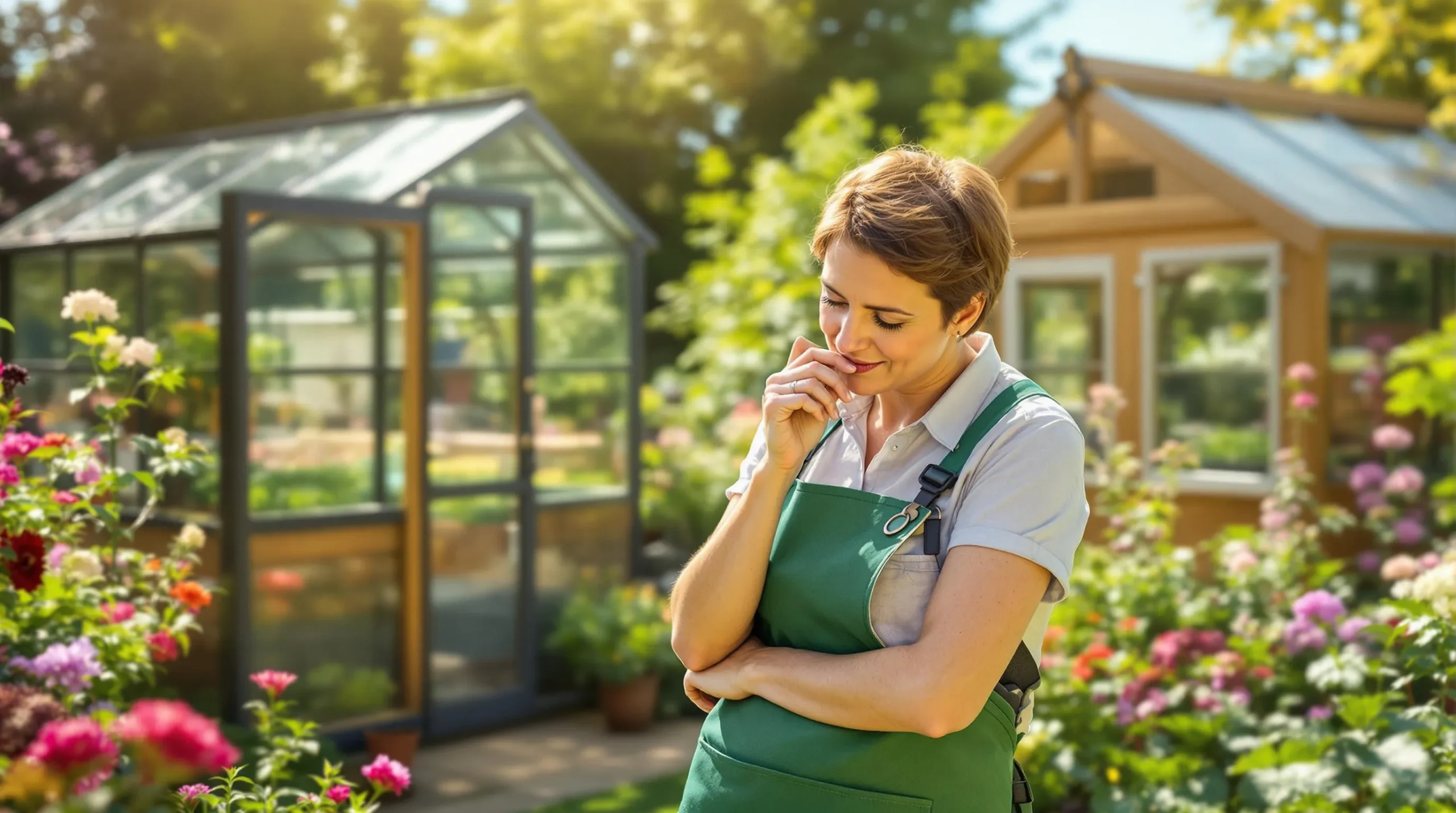
How to Choose Your First Greenhouse: A Complete Beginner’s Guide for 2025
Learn how to choose your perfect first greenhouse with our expert guide. Discover size, materials, and features to extend your growing season by 2-3 months.
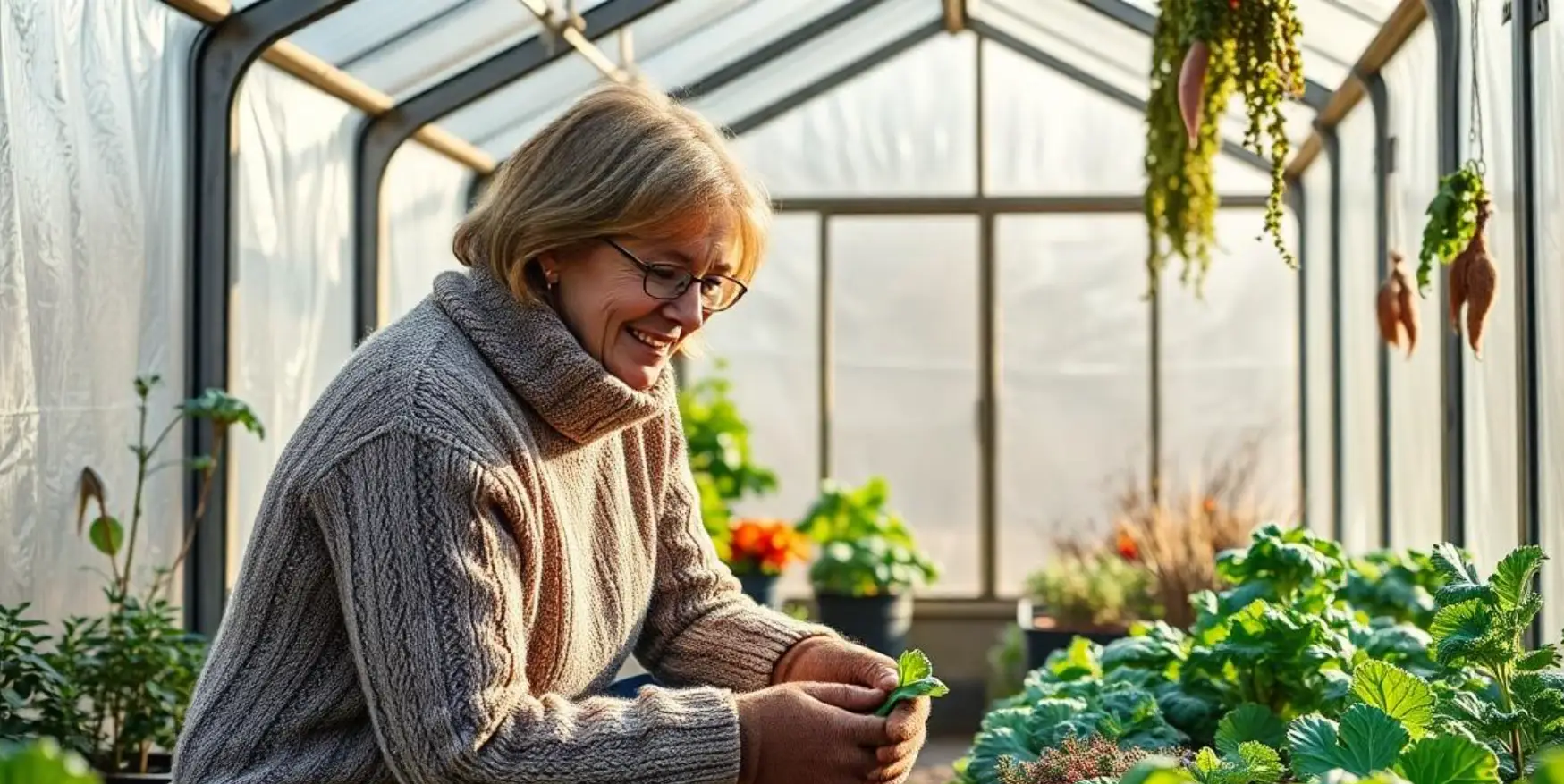
Wondering if your greenhouse can remain productive during the frosty winter months? You’ll be delighted to know that winter greenhouse gardening offers abundant possibilities for year-round harvests. With proper planning, you can grow a variety of cold-tolerant vegetables and extend your growing season well beyond autumn.
A greenhouse provides crucial protection from harsh elements, creating a controlled environment where plants can thrive even though the cold outdoor temperatures. You can cultivate everything from leafy greens like rocket and lettuce to heartier vegetables such as carrots, broccoli, and kohlrabi. Whether you have a heated or unheated greenhouse, there’s a surprising range of crops that will flourish with the right care and attention during the winter months.
Winter greenhouse gardening transforms the cold season into a productive growing period, allowing you to harvest fresh vegetables when outdoor gardens lie dormant. A greenhouse captures solar energy and shelters cold-tolerant crops from harsh weather, creating a microclimate that extends your growing season through the darkest months.
Winter greenhouses work by trapping solar heat during daylight hours. The transparent walls and roof allow sunlight to enter and warm the interior space, while the structure itself blocks cold winds and prevents heat from escaping. This solar energy collection creates a temperature difference of 5-10°C compared to outside conditions, even in unheated structures.
For maximum efficiency in winter:
Winter greenhouse growing offers numerous advantages for year-round gardeners. The protected environment allows you to grow cold-tolerant vegetables that wouldn’t survive outdoors, giving you access to fresh produce throughout December, January, February and March.
Winter greenhouse benefits include:
Different greenhouse structures suit different winter gardening needs depending on your climate and growing goals. Cold frames offer minimal protection for hardy crops, while fully heated structures can support temperature-sensitive plants year-round.
Common winter greenhouse options include:
| Greenhouse Type | Temperature Range | Best For | Relative Cost |
|---|---|---|---|
| Cold Frame | 2-8°C above outdoor | Hardy greens, root crops | £50-200 |
| Unheated Greenhouse | 5-10°C above outdoor | Cold-tolerant vegetables | £300-2,000 |
| Heated Greenhouse | Maintains minimum temp | Wide crop variety | £500-5,000+ heating costs |
| Attached Lean-to | Varies (shares house heat) | Mixed growing, seedling starting | £200-1,500 |
When selecting your winter greenhouse, consider your climate, space constraints, budget and preferred crops. For many UK gardeners, an unheated structure with good insulation provides the perfect balance between cost-effectiveness and growing potential.
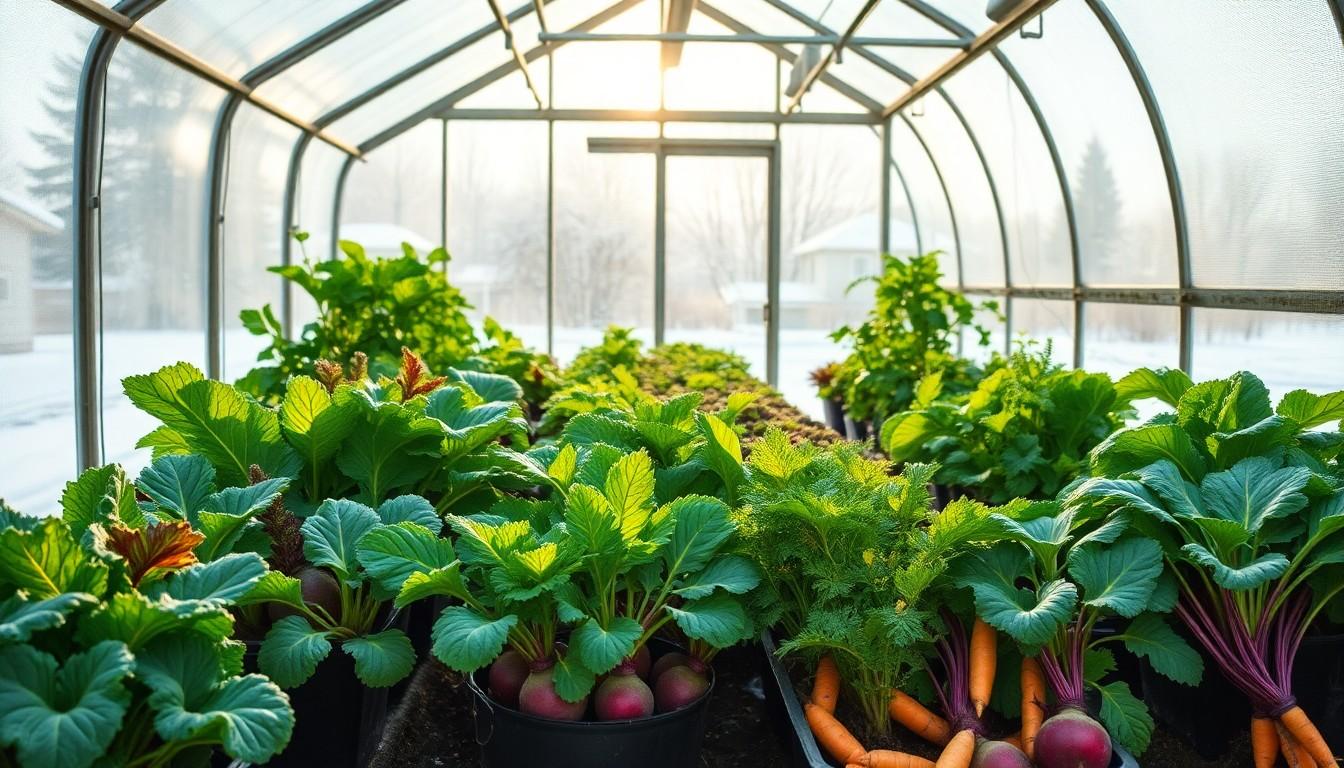
Winter greenhouse gardening opens up possibilities for growing fresh vegetables even during the coldest months. With proper selection of cold-tolerant varieties, you’ll enjoy homegrown produce when supermarket prices peak and garden offerings are typically sparse.
Leafy greens thrive exceptionally well in winter greenhouses, providing nutrient-rich harvests throughout the cold season. Kale stands out as a winter superstar, tolerating temperatures as low as -6°C, making it perfect for unheated structures. Varieties like Winterbor kale continue producing through the harshest conditions, providing vitamin-packed leaves for soups and stews.
Spinach varieties such as Merlo Nero and Riccio d’Asti perform brilliantly in unheated greenhouses, offering continuous harvests throughout winter. You can pick outer leaves repeatedly, allowing the plants to keep producing fresh growth.
Pak Choi grows quickly in greenhouse conditions and can be sown as late as October for winter harvesting. This oriental vegetable takes approximately 30 days for leaf harvest and 70 days for full plant maturity, adding variety to winter meals.
Broccoli thrives when kept at optimal greenhouse temperatures. Varieties like ‘Belstar’ and purple sprouting broccoli work particularly well in winter conditions, providing nutritious heads when outdoor gardens lie dormant.
Brussels sprouts require about three months to mature and can be harvested as late as March. These cold-tolerant brassicas actually prefer cooler temperatures, developing sweeter flavour after exposure to light frost.
Hardy root crops excel in unheated greenhouses where soil provides natural insulation against cold. Carrots become noticeably sweeter in winter as cold temperatures trigger sugar conversion in the roots. Larger varieties like Danvers resist cracking and perform well with ample mulch protecting their shallow roots.
Beets add vibrant colour to winter plates and grow successfully in greenhouse conditions. Covering the soil with straw mulch provides essential insulation, preventing woody texture. Harvest beets while young for tender roots with superior flavour and texture.
Parsnips, leeks, and rutabagas offer excellent winter greenhouse options for experimenting with new varieties. These robust root vegetables utilise underground growing environments where soil temperature remains more stable than air temperature, making them reliable producers even in challenging conditions.
Fresh winter salads become possible with cold-hardy lettuce varieties specifically bred for low-temperature performance. Winter Density, North Pole, and Salanova lettuces significantly outperform summer varieties during December through March, standing up remarkably well to cold temperatures.
Endive and radicchio provide frost-tolerant alternatives to traditional lettuce, adding distinctive flavours and textures to winter salads. Their slight bitterness balances perfectly with sweet winter root vegetables in composed salads.
Mache (also called corn salad) and arugula count among the most reliable winter salad crops. Mache particularly excels in cold conditions, developing sweet, nutty flavour unmatched by summer-grown alternatives.
Swiss chard contributes both beauty and nutrition to winter greenhouse growing. Its large, colourful leaves act as natural insulators for the plant’s crown, while regular harvesting of outer leaves promotes continued growth. Apply mulch around plants to protect their shallow feeder roots from soil freezing.
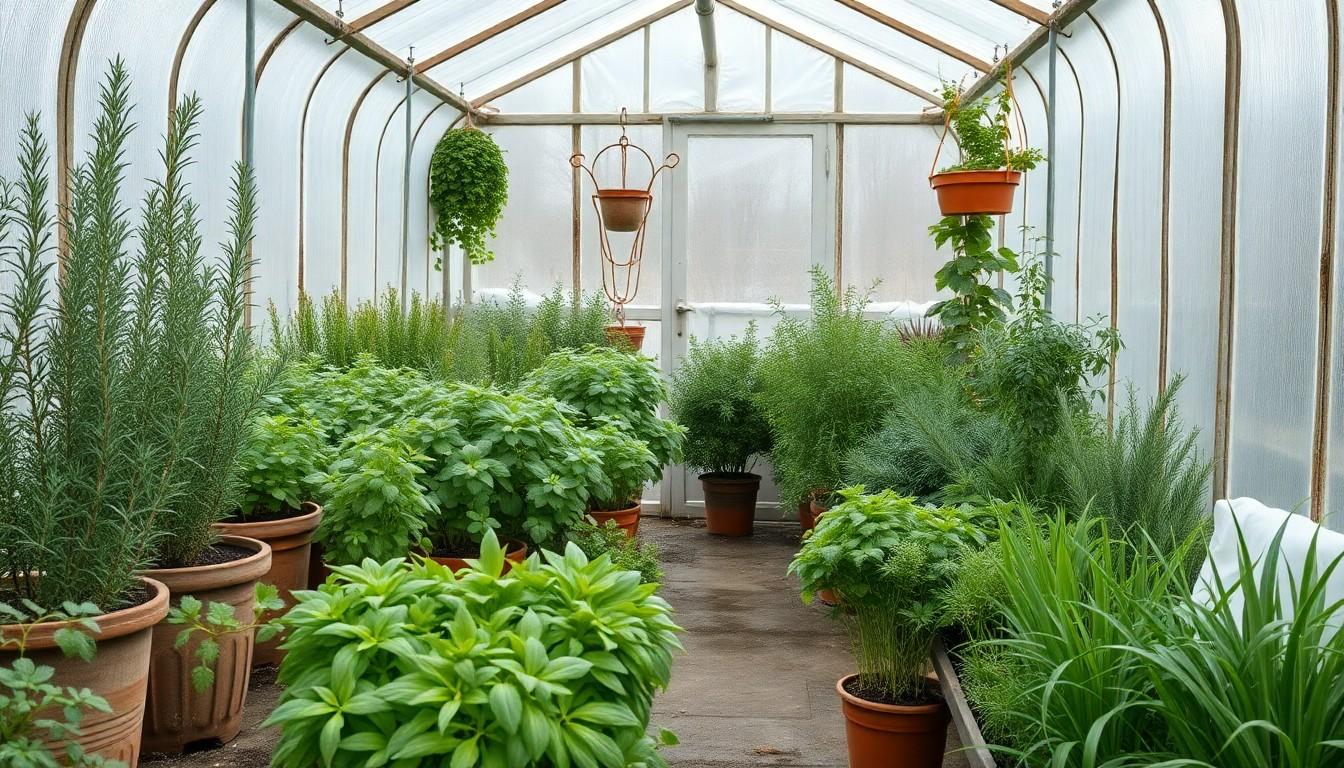
Growing herbs in a greenhouse during winter offers you fresh flavours for your kitchen when outdoor gardening isn’t possible. Many herbs adapt surprisingly well to cooler conditions, especially those native to temperate climates with their natural resilience to winter weather.
Rosemary and thyme continue growing in greenhouse environments throughout winter, making them excellent choices for cold-season cultivation. These Mediterranean herbs thrive in an unheated greenhouse, though they benefit from additional protection during particularly harsh frosts.
Rosemary blooms at around 10°C, adding both beauty and fragrance to your winter greenhouse. For best results, apply heavy mulch around potted rosemary but avoid direct contact with stems to prevent moisture retention that leads to root rot. If temperatures drop below -6°C, you might need to relocate potted plants indoors.
Thyme appreciates the higher humidity levels provided by a greenhouse environment. To prevent stem rot issues, add granite grit to your potting mix to improve drainage. During colder periods, protect your thyme plants with horticultural fleece or crop covers to maintain steady growth throughout winter.
Mint’s remarkable resilience makes it an outstanding winter greenhouse herb. This versatile plant continues growing through light snow cover, demonstrating its exceptional cold tolerance. Mint’s vigorous nature means it performs well in both pots and beds, giving you flexibility in your greenhouse setup.
The refreshing flavour of mint remains available throughout winter, providing a welcome addition to hot drinks and winter dishes. Its rapid regrowth after harvesting ensures a continuous supply of fresh leaves even during the coldest months.
Parsley performs exceptionally well in winter conditions, particularly curly varieties like Dark Moss Curled. Young parsley plants overwinter successfully in a greenhouse, providing fresh leaves for months.
For parsley to thrive during winter:
Parsley’s growth slows during the coldest days but picks up again as temperatures rise, ensuring you’ll never be without this versatile herb.
Both Chinese chives and regular chives overwinter reliably in a greenhouse environment. These hardy perennials adapt to winter conditions with minimal care, making them low-maintenance additions to your greenhouse herb collection.
Chives offer remarkable flexibility in growing conditions, thriving in either pots or fixed garden beds. For winter greenhouse cultivation, simply dig established plants from outdoor beds in early autumn and transplant them inside your greenhouse structure. The mild onion flavour of chives enhances winter soups, potatoes, and egg dishes when other fresh herbs are scarce.
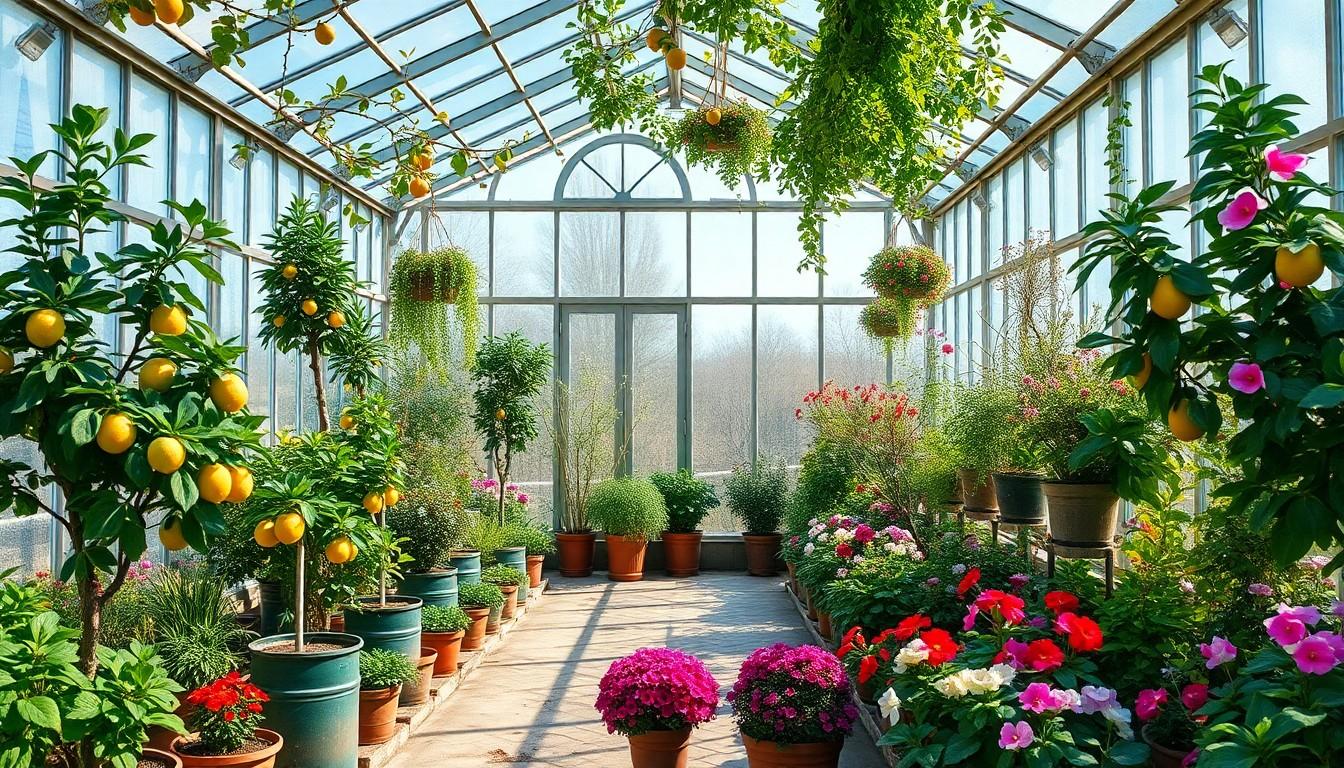
Winter greenhouse gardening offers opportunities to grow select fruits even though the cooler conditions. Citrus and fig trees thrive when moved into a greenhouse before the first frost. These potted plants can continue producing fruit throughout the winter months, adding fresh flavours to your winter diet when placed in a protected environment.
Though less common than vegetables, these winter fruits provide a rewarding harvest during colder months:
Winter flowering plants bring essential colour during the darkest months of the year. A greenhouse creates the perfect environment for growing vibrant blooms when outdoor gardens lie dormant.
Try these winter-friendly flower varieties in your greenhouse:
Other excellent choices include snapdragons (antirrhinums), laurentia, begonias and geraniums. These flowers add beauty and vibrancy to your greenhouse and home during the dark winter months. Many winter greenhouse flowers thrive in temperatures around 5-10°C, making them suitable for minimally heated structures.
When growing winter flowers, position plants where they’ll receive maximum sunlight, as winter daylight hours are limited. Water sparingly, as cooler temperatures reduce evaporation rates. Check plants regularly for signs of mould or mildew, which can develop in the humid winter greenhouse environment.
By incorporating both fruits and flowers into your winter greenhouse, you’ll create a productive and visually appealing growing space that delivers harvests and blooms throughout the coldest months of the year.
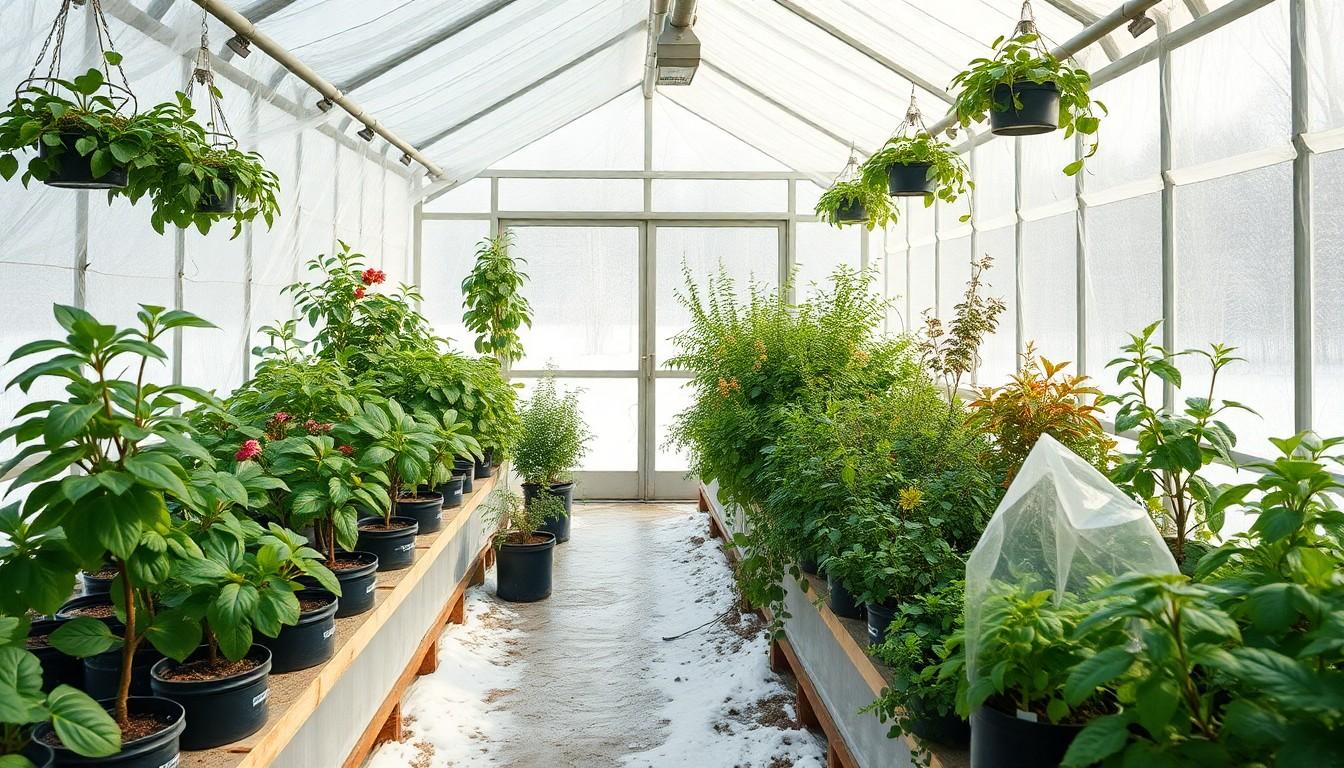
A properly set up greenhouse transforms winter from a dormant season into a productive growing period. By managing temperature, light, moisture, and pests effectively, you’ll create the ideal environment for your winter crops to flourish.
Temperature management forms the foundation of successful winter greenhouse gardening. Unheated greenhouses typically remain 5-10°C warmer than outdoor temperatures, providing sufficient protection for cold-hardy crops. To maximize heat retention:
For heated greenhouses, set thermostats to maintain minimum temperatures of 7-10°C for cool-season crops. Electric fan heaters, propane heaters, or paraffin heaters all work effectively when sized appropriately for your greenhouse space.
Winter light levels significantly impact plant growth even though shorter days. Proper light management involves:
Moisture management requires a different approach in winter:
Winter greenhouses create perfect conditions for certain pests and diseases if not properly managed. Carry out these preventative measures:
Regular monitoring is essential – check the undersides of leaves twice weekly for early signs of pest activity. Powdery mildew and botrytis (grey mould) are common winter greenhouse diseases that thrive in humid, poorly ventilated conditions. Appropriate spacing between plants and careful watering practices significantly reduce disease pressure during winter months.
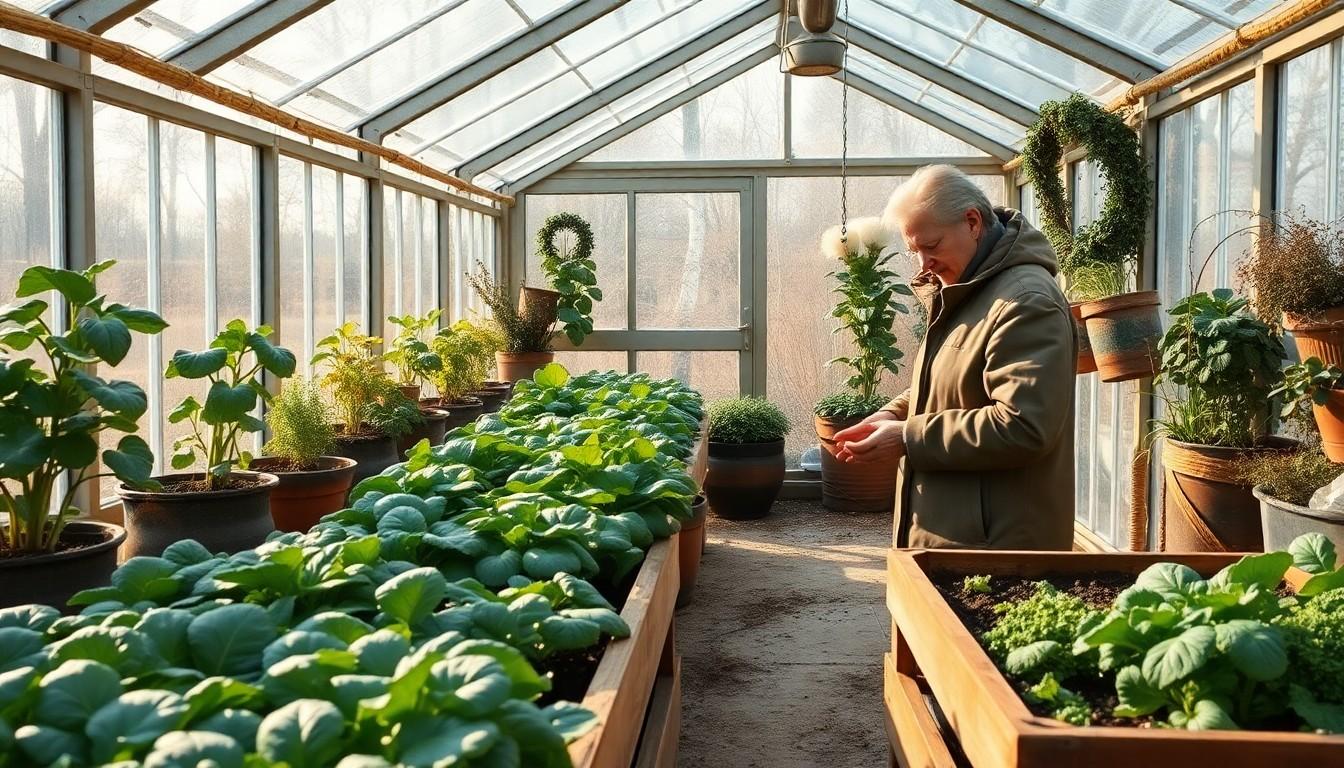
Growing plants in a greenhouse during winter requires planning and adapting to changing conditions. This monthly guide helps you maximize your winter greenhouse production with timely planting suggestions and maintenance tasks for each stage of the cold season.
Early winter offers opportunities to start several crops in your greenhouse that will provide harvests through the colder months and into early spring. Focus on cold-tolerant varieties that can thrive in the decreasing light levels.
During the coldest months, plant growth typically slows or pauses. This period requires patience and careful greenhouse management. Plants may show little visible growth for weeks, especially in December-January, which is completely normal.
Remember that winter greenhouse growing operates on a different timeline than summer gardening. Plants might require double the usual growing time depending on your local weather conditions. As days begin to lengthen in late February, you’ll notice growth rates increasing, signaling the transition toward spring.
Your winter greenhouse opens a world of growing possibilities even as the landscape outside lies dormant. By selecting cold-tolerant varieties and implementing proper temperature light and moisture management you’ll enjoy harvests throughout the coldest months.
Whether you’re cultivating hardy kale protecting citrus trees or forcing early spring bulbs a greenhouse transforms winter from a gardening pause into a productive season. The satisfaction of harvesting fresh herbs and vegetables when they’re scarce elsewhere makes the effort worthwhile.
Remember that winter greenhouse gardening follows its own rhythm requiring patience and observation. As you gain experience you’ll develop a growing calendar that works perfectly for your specific conditions. So clean those panels insulate where needed and enjoy the green oasis you’ve created while the frost settles outside.
You can grow a variety of cold-tolerant vegetables in a winter greenhouse, including leafy greens like kale, spinach and rocket; hardy root vegetables such as carrots, parsnips and leeks; brassicas like broccoli and Brussels sprouts; and winter salads featuring hardy lettuce varieties. Herbs such as rosemary, thyme, mint and parsley also thrive, as do some fruits like alpine strawberries and citrus trees with proper protection.
No, you don’t necessarily need a heated greenhouse. Unheated greenhouses work brilliantly for many cold-tolerant plants, especially in milder UK regions. They typically maintain temperatures 5°C warmer than outside, which is sufficient for many winter crops. Heated greenhouses do extend your growing options but come with running costs. Cold frames and lean-to structures can also be effective, more affordable alternatives depending on your space and needs.
Winter greenhouses work by trapping solar energy to create a protected microclimate. Their transparent walls allow sunlight to enter and convert to heat, which is then trapped inside the structure. This solar gain, combined with protection from frost, cold winds and snow, extends the growing season significantly. The enclosed environment also reduces moisture loss from plants and soil, creating more stable growing conditions despite harsh weather outside.
The best vegetables for an unheated greenhouse in winter include leafy greens like kale, spinach and pak choi; root vegetables including carrots, parsnips and leeks; and hardy brassicas such as broccoli and Brussels sprouts. Winter salad crops like mache, endive and certain lettuce varieties also perform well. These plants are naturally adapted to cooler temperatures and will continue growing (albeit more slowly) throughout the winter months.
Insulate your greenhouse by lining the inside with bubble wrap, particularly on north-facing sides. Use thermal mass objects like water-filled containers or stone slabs to absorb heat during the day and release it at night. Seal any gaps or cracks where cold air might enter. Apply weatherstripping around doors and vents. For supply lines, use pipe insulation to prevent freezing. Consider adding a layer of horticultural fleece over plants on extremely cold nights for additional protection.
Water plants in a winter greenhouse sparingly and carefully. Most plants require significantly less water in winter due to reduced evaporation and slower growth. Water in the morning to allow moisture to evaporate before nightfall. Check soil moisture by inserting your finger 1-2 inches into the soil—only water if it feels dry. Focus watering at the soil level rather than on foliage to prevent fungal issues. Generally, watering once every 7-10 days is sufficient for most winter crops.
Yes, you can grow several flower varieties in a winter greenhouse. Sweet peas can be started for early spring blooms, while cyclamen and primroses provide winter colour. Spring bulbs like tulips and daffodils can be forced for early flowering. Position flowers to receive maximum available sunlight and maintain good air circulation to prevent disease. Flowering plants generally need slightly warmer conditions than leafy vegetables, so cluster them together or in the warmest part of your greenhouse.
Common winter greenhouse pests include aphids, whiteflies, spider mites and slugs. Inspect plants regularly, paying attention to leaf undersides. Maintain good airflow to discourage fungal issues and pests that thrive in humid conditions. Remove yellowing or damaged leaves promptly. Consider introducing beneficial insects like ladybirds for natural pest control. Organic insecticidal soaps can help with serious infestations. Unlike summer, winter typically sees reduced pest pressure, making it easier to maintain healthy plants.
Start planting your winter greenhouse from late summer through autumn (August-October) to establish plants before the coldest weather arrives. Early winter (November-December) is still suitable for planting cold-tolerant crops like winter lettuce, spinach and kale. Mid-winter (January-February) works well for starting early spring crops and fast-growing options like microgreens. Remember that winter growth is slower, so allow extra time for maturity compared to summer growing schedules.
Winter greenhouse gardening can be very cost-effective, especially for unheated structures. While there’s an initial investment in the greenhouse itself, ongoing costs are minimal for unheated options. You’ll save money on produce during winter when supermarket prices peak, particularly for salad greens and herbs. Growing your own also reduces food miles and plastic packaging. Heated greenhouses have higher running costs, but extending your growing season often justifies the expense for dedicated gardeners seeking year-round harvests.

Learn how to choose your perfect first greenhouse with our expert guide. Discover size, materials, and features to extend your growing season by 2-3 months.
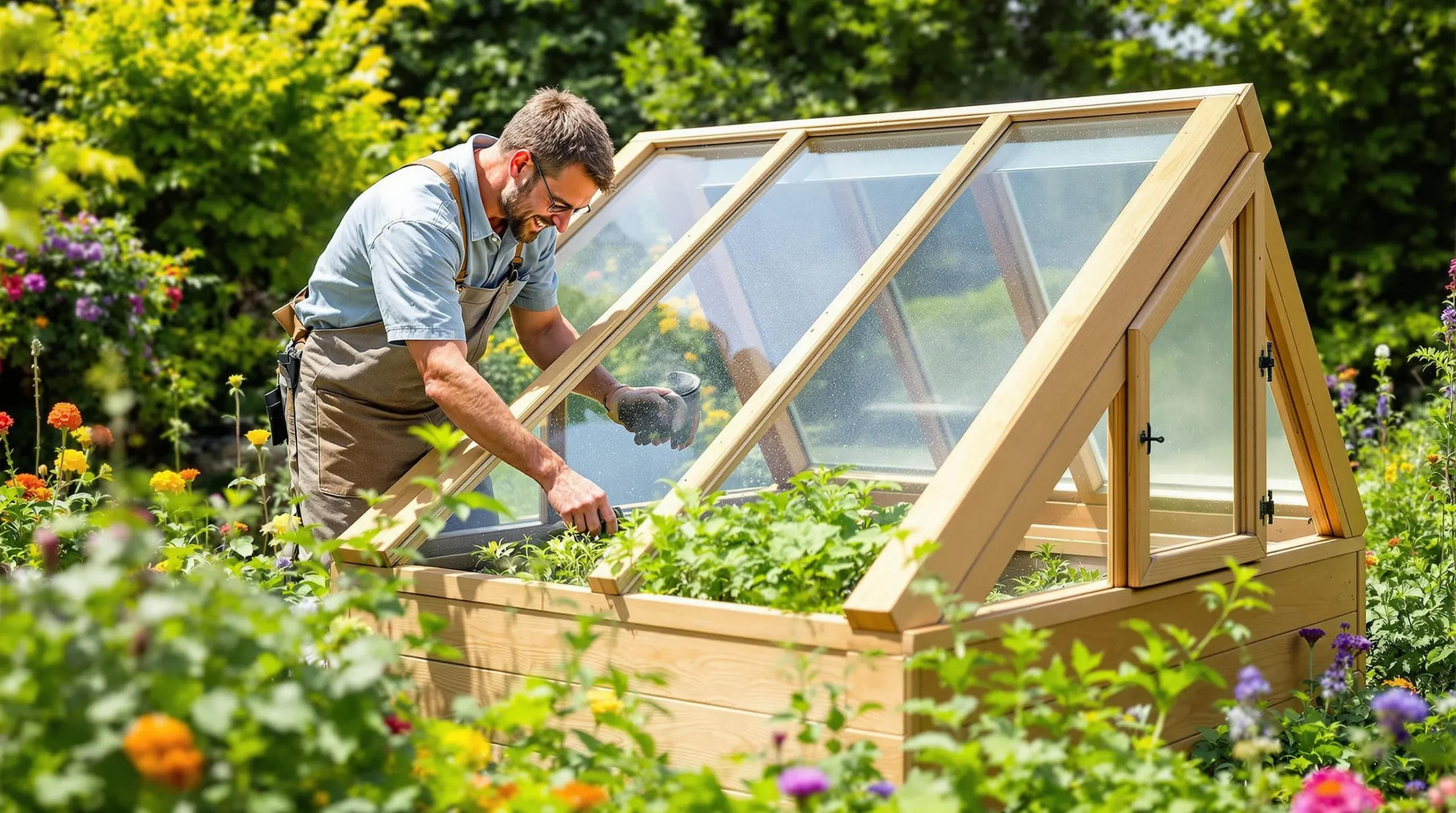
Learn how to make a cold frame to extend your growing season, protect plants in winter, and grow seedlings all year. Simple, cost-effective, and DIY-friendly!